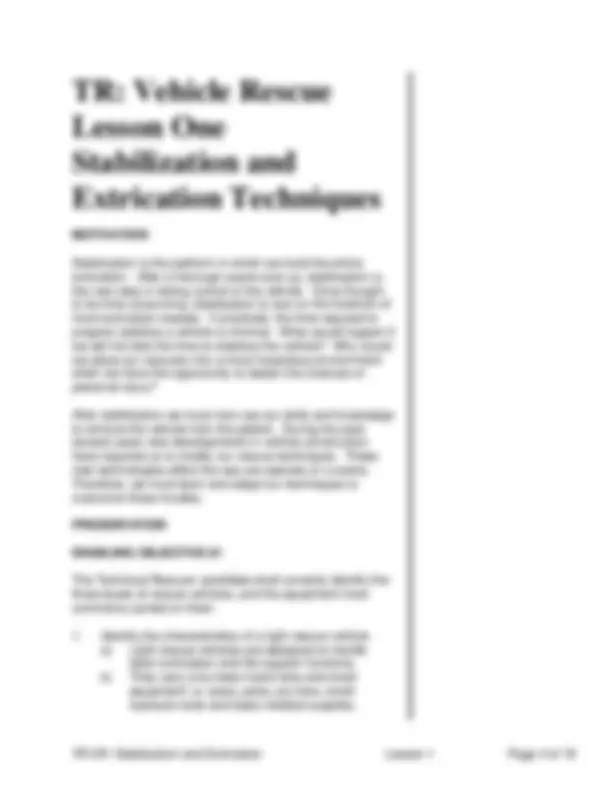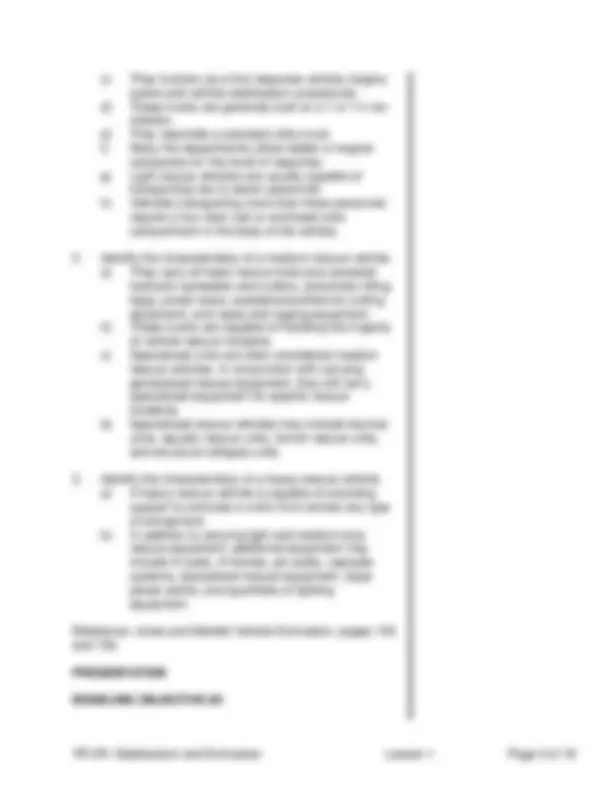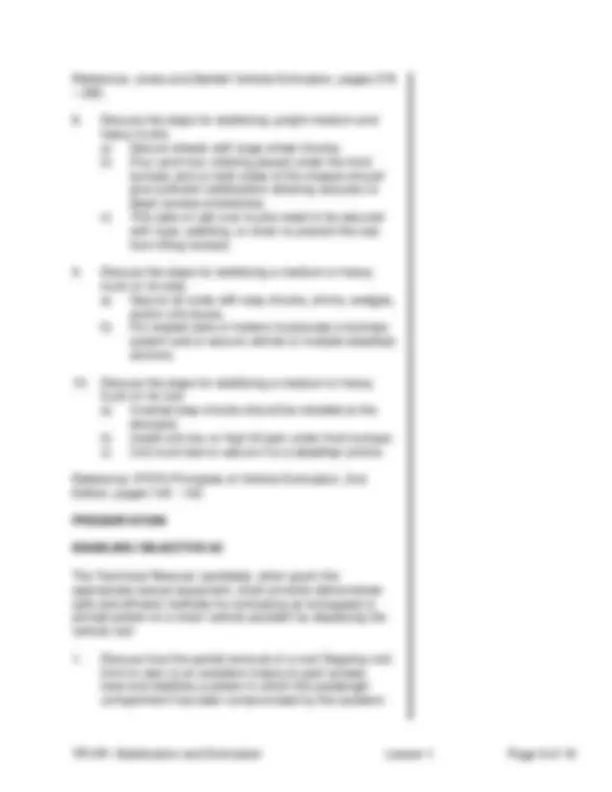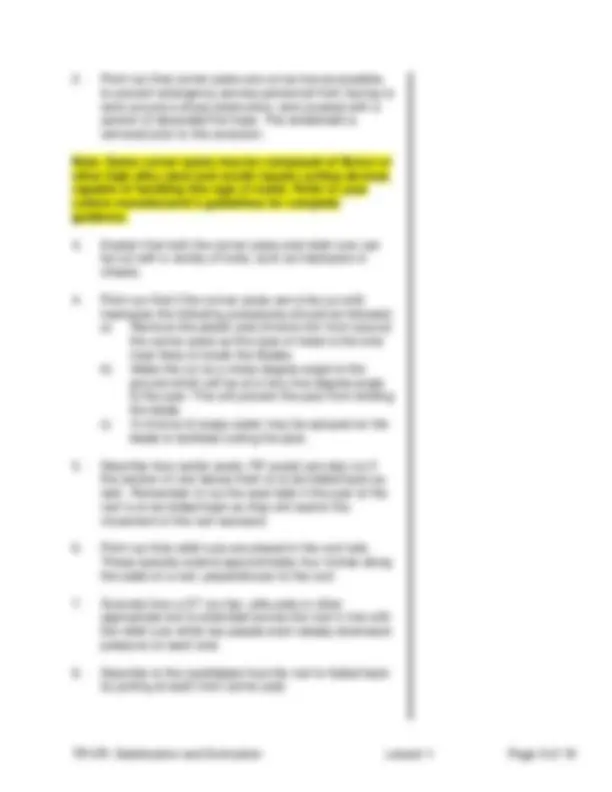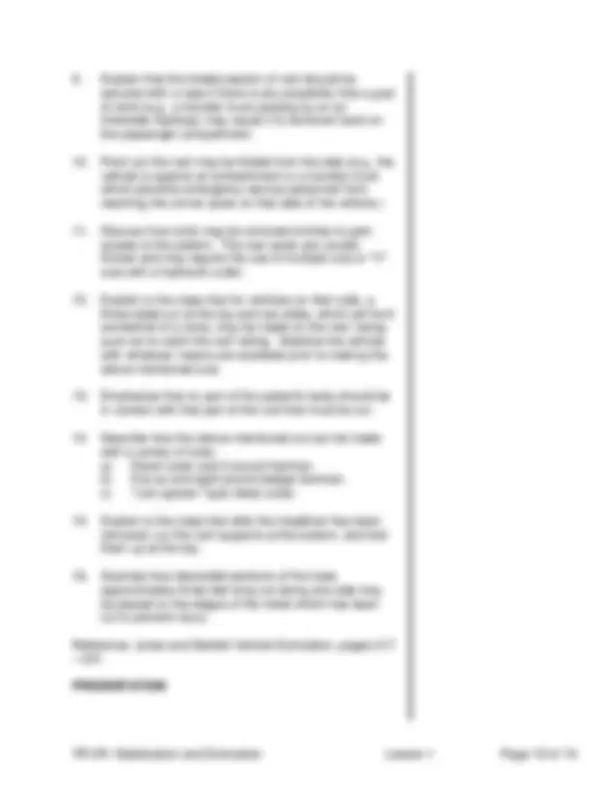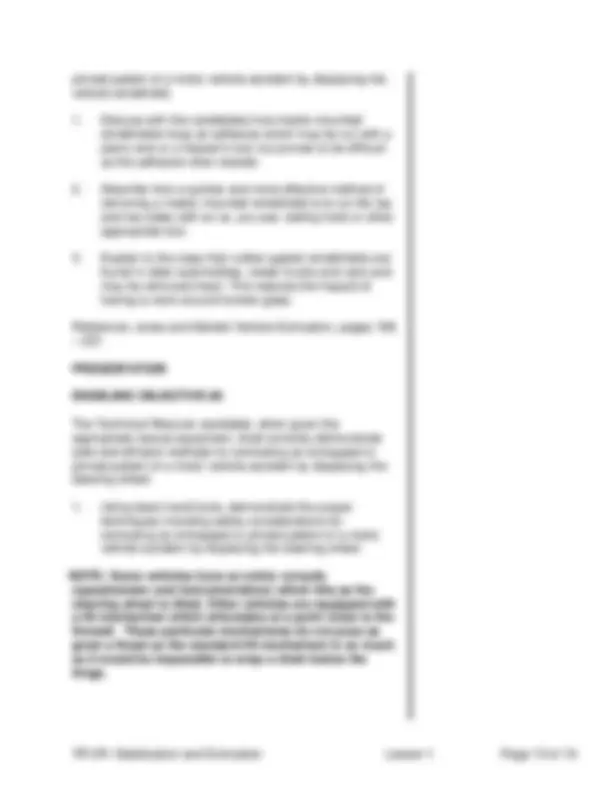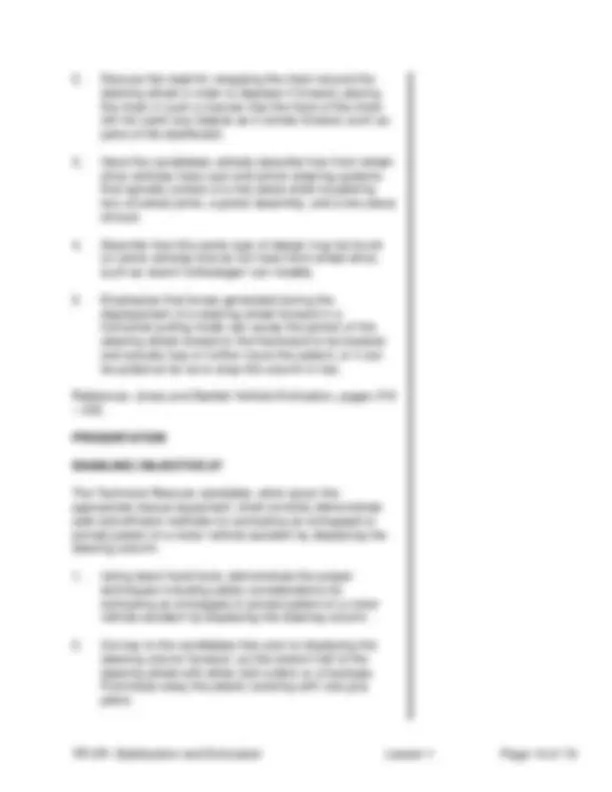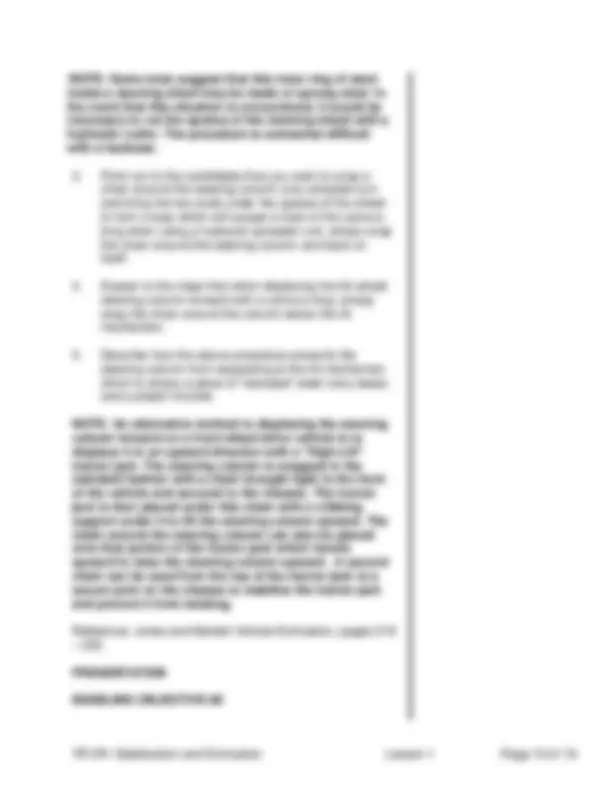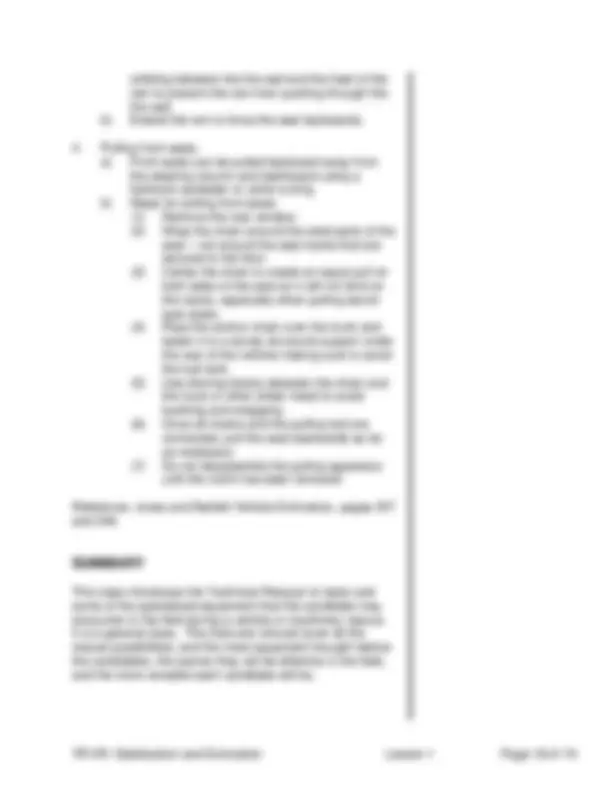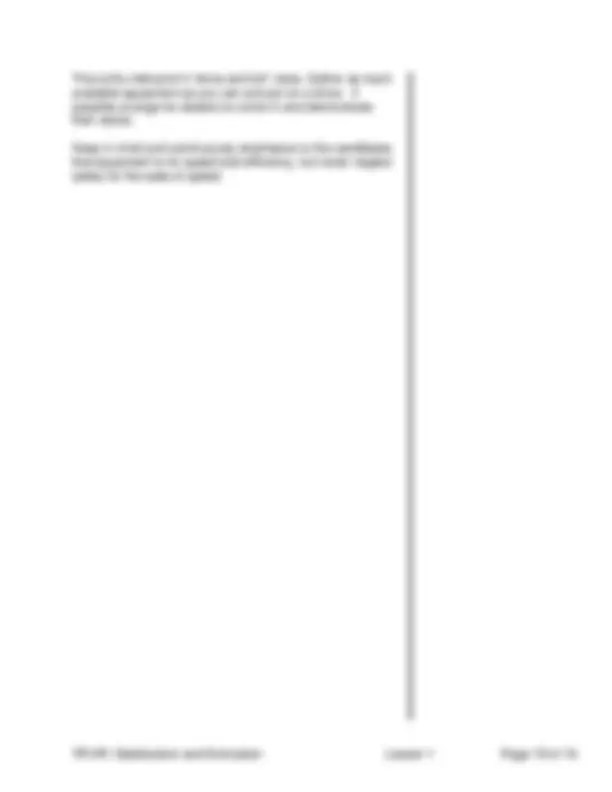Download Vehicle Rescue: Stabilization and Extrication Techniques and more Exercises Construction in PDF only on Docsity!
TR: Vehicle Rescue
Lesson One
Stabilization and
Extrication Techniques
DOMAIN: COGNITIVE / PSYCHOMOTOR
LEVEL OF LEARNING: COMPREHENSION /
APPLICATION
MATERIALS
IFSTA Principles of Vehicle Extrication, 2nd Edition; IFSTA Essentials 5th Edition; NFPA 1006 Standard for Technical Rescuer Professional Qualifications, 2013 Edition; Vehicle Rescue and Extrication by Ronald E. Moore; NFPA Operations and Training for Technical Rescue Incidents; various types of rescue equipment used by the AHJ (Authority Having Jurisdiction) such as: cribbing block, step chocks, shims, pneumatic lifting bags, pneumatic shoring struts, timber, rope and rigging material, crutches, high lift jacks, tow trucks are optional per instructor level of knowledge, basic hand tools, pneumatic and hydraulic and electric operated tools, both corded and cordless, and rated chains; generators and lighting equipment; and various types of vehicles available to the AHJ for practicing the proper use of the equipment covered in this lesson plan. Vehicles in the VMR lesson plans include passenger vehicles, trucks, buses, industrial moving machinery, and farm machinery. Laptop computer, multimedia projector and whiteboard or flipchart, and marking pens.
NOTE: The mentioned vehicles and machinery are only suggestions. Practice on all of these types of vehicles and machinery is not mandatory to complete the objectives of the lesson plan. Selection should be based on availability and AHJ needs. Practical skills testing for the Technical Rescuer candidate is based on passenger vehicle extrication.
OBJECTIVE PAGE
NFPA 1006, 2013 Edition JPRs
10.1.3 Establish fire protection and fire control support 10.1.4 Stabilize a vehicle 10.1.5 Isolate and manage potentially harmful energy sources within a vehicle 10.1.6 Determine vehicle access and egress points 10.1.7 Create access and egress openings for rescue 10.2.1 Plan for a heavy vehicle incident 10.2.2 Stabilize heavy vehicles 10.2.3 Determine access and egress points for heavy vehicles 10.2.4 Create access and egress openings for a rescue from heavy vehicles 10.2.6 Isolate and manage potentially harmful energy sources within heavy vehicles
Junior Member Statement:
Junior Member training activities should be supervised by qualified instructors to assure that the cognitive and psychomotor skills are completed in a safe and non-evasive manner. While it is critical that instructors be constantly aware of the capabilities of all students both mentally and physically to complete certain tasks safely and successfully, the instructor should take every opportunity to discuss with departmental leaders and students the maturity and job awareness each participant has for the hazards associated with fire and rescue training.
TERMINAL OBJECTIVE
The Technical Rescuer candidate shall correctly identify, describe the function, and demonstrate the operation of various tools and equipment commonly used for vehicle and machinery extrication rescue.
ENABLING OBJECTIVES
- The Technical Rescuer candidate shall correctly identify the three levels of rescue vehicles, and the equipment most commonly carried on them.
- The Technical Rescuer candidate, when given the appropriate rescue equipment, shall correctly
OBJECTIVE PAGE
TR: Vehicle Rescue
Lesson One
Stabilization and
Extrication Techniques
MOTIVATION
Stabilization is the platform in which we build the entire extrication. After a thorough scene size-up, stabilization is the next step in taking control of the vehicle. Once thought to be time consuming, stabilization is now on the forefront of most extrication classes. If practiced, the time required to properly stabilize a vehicle is minimal. What would happen if we did not take the time to stabilize the vehicle? Why would we place our rescuers into a more hazardous environment when we have the opportunity to lessen the chances of personal injury?
After stabilization we must now use our skills and knowledge to remove the vehicle from the patient. During the past several years new developments in vehicle construction have required us to modify our rescue techniques. These new technologies affect the way we operate on a scene. Therefore, we must learn and adapt our techniques to overcome these hurdles.
PRESENTATION
ENABLING OBJECTIVE #
The Technical Rescuer candidate shall correctly identify the three levels of rescue vehicles, and the equipment most commonly carried on them.
- Identify the characteristics of a light rescue vehicle. a) Light rescue vehicles are designed to handle basic extrication and life-support functions. b) They carry only basic hand tools and small equipment i.e. saws, jacks, pry bars, small hydraulic tools and basic medical supplies.
c) They function as a first response vehicle; begins scene and vehicle stabilization procedures. d) These trucks are generally built on a 1 or 1½ ton chassis. e) They resemble a standard utility truck. f) Many fire departments utilize ladder or engine companies for this level of response. g) Light rescue vehicles are usually capable of transporting two to seven personnel. h) Vehicles transporting more than three personnel require a four-door cab or enclosed crew compartment in the body of the vehicle.
- Identify the characteristics of a medium rescue vehicle. a) They carry all basic rescue tools plus powered hydraulic spreaders and cutters, pneumatic lifting bags, power saws, acetylene/exothermic cutting equipment, and ropes and rigging equipment. b) These trucks are capable of handling the majority of vehicle rescue incidents. c) Specialized units are often considered medium rescue vehicles. In conjunction with carrying generalized rescue equipment, they will carry specialized equipment for specific rescue incidents. d) Specialized rescue vehicles may include hazmat units, aquatic rescue units, trench rescue units, and structural collapse units.
- Identify the characteristics of a heavy rescue vehicle. a) A heavy rescue vehicle is capable of providing support to extricate a victim from almost any type of entrapment. b) In addition to carrying light and medium duty rescue equipment, additional equipment may include tri-pods, A-frames, gin poles, cascade systems, specialized rescue equipment, large power plants, and quantities of lighting equipment.
Reference: Jones and Bartlett Vehicle Extrication, pages 135 and 136.
PRESENTATION
ENABLING OBJECTIVE #
d) Instability of the middle of the undercarriage may require a third set of step chocks or crib box. e) Vehicles upright and on an incline may require additional anchoring to a steadfast anchor.
- Discuss the steps for stabilizing a vehicle on its side. a) Establish fire control for leaking fuels and fluids. b) Shim all voids. c) A buttress system or modified raker shore with a minimum of four contact points works well. d) Ground base plates should be secured to a stable anchor point on the vehicle. e) Tying all rakers together increases stability.
- Discuss the steps for stabilizing a vehicle on its top. a) A buttress system works well. b) If cribbing is used to fill voids, the height of the crib box should not exceed two times the length of cribbing material with a maximum height of 36”. The two most common type of cribbing material used for vehicle stabilization are wood and plastic. c) When using a crib box as a base for a lifting tool, such as a lifting bag, spreader, or jack, the top of the box must be solid all the way across. d) The most common dimensions are 4” x 4” x 18” - 24 ” long. e) Chains, utility rope and come-a-longs rated for the load can provide added stabilization security. f) When using pneumatic lifting bags to stabilize a vehicle, protect them from punctures, and exposure to excessive heat. g) Follow the manufacturer guidelines for safe use.
Reference: Jones and Bartlett Vehicle Extrication, pages 176
- Discuss the steps for stabilizing a bus. a) Procedures and tools for stabilizing a bus in any position should follow the same principles as for passenger vehicles. b) The number of stabilization points is greater and the recommended guidelines is to stabilize a bus in three or more places.
Reference: Jones and Bartlett Vehicle Extrication, pages 278
- Discuss the steps for stabilizing upright medium and heavy trucks. a) Secure wheels with large wheel chocks. b) Four point box cribbing placed under the front bumper and on both sides of the chassis should give sufficient stabilization allowing rescuers to begin access procedures. c) The cabs of cab over trucks need to be secured with rope, webbing, or chain to prevent the cab from tilting forward.
- Discuss the steps for stabilizing a medium or heavy truck on its side. a) Secure all voids with step chocks, shims, wedges, and/or crib boxes. b) For angled cabs or trailers incorporate a buttress system and or secure vehicle to multiple steadfast anchors.
- Discuss the steps for stabilizing a medium or heavy truck on its roof. a) Inverted step-chocks should be installed at the doorpost. b) Install crib box or high lift jack under front bumper. c) Crib truck bed or secure it to a steadfast anchor.
Reference: IFSTA Principles of Vehicle Extrication, 2nd Edition, pages 140 - 142.
PRESENTATION
ENABLING OBJECTIVE #
The Technical Rescuer candidate, when given the appropriate rescue equipment, shall correctly demonstrate safe and efficient methods for extricating an entrapped or pinned patient of a motor vehicle accident by displacing the vehicle roof.
- Discuss how the partial removal of a roof (flapping roof, front to rear) is an excellent means to gain access, treat and stabilize a patient in which the passenger compartment has been compromised by the accident.
- Explain that this folded section of roof should be secured with a rope if there is any possibility that a gust of wind (e.g., a transfer truck passing by on an interstate highway) may cause it to be blown back on the passenger compartment.
- Point out the roof may be folded from the side (e.g., the vehicle is against an embankment or a transfer truck which prevents emergency service personnel from reaching the corner posts on that side of the vehicle.)
- Discuss how roofs may be removed entirely to gain access to the patient. The rear posts are usually thicker and may require the use of multiple cuts or "V" cuts with a hydraulic cutter.
- Explain to the class that for vehicles on their side, a three-sided cut at the top and two sides, which will form somewhat of a ramp, may be made on the roof, being sure not to catch the roof railing. Stabilize the vehicle with whatever means are available prior to making the above mentioned cuts.
- Emphasize that no part of the patient's body should be in contact with that part of the roof that must be cut.
- Describe how the above mentioned cut can be made with a variety of tools: a) Panel cutter and 2 pound hammer. b) Fire ax and eight pound sledge hammer. c) “Can-opener" type metal cutter.
- Explain to the class that after the headliner has been removed, cut the roof supports at the bottom, and fold them up at the top.
- Illustrate how discarded sections of fire hose approximately three feet long cut along one side may be placed on the edges of the metal which has been cut to prevent injury.
Reference: Jones and Bartlett Vehicle Extrication, pages 217
PRESENTATION
ENABLING OBJECTIVE
The Technical Rescuer candidate, when given the appropriate rescue equipment, shall correctly demonstrate safe and efficient methods for extricating an entrapped or pinned patient of a motor vehicle accident by displacing the vehicle door.
- Point out that doors are often used as a means of gaining access as well as extrication of the patient.
- Explain how American automobiles have a latching device which closes around a strykor bolt ("Nader Nail.”)
- Point out that on passenger cars, multipurpose passenger vehicles and trucks; a door locking mechanism is required to withstand a minimum of 2,500 lbs. before separating when a longitudinal load is applied. A Toyota latch is rated at 3,500 lbs. while a Mercedes Benz is rated at 5,800 lbs.
- Explain that foreign cars as well as older vehicles may have a door locking mechanism which pinches a pin.
- Describe how plunger type door handles may be removed with a hammer with the locking mechanism disengaged with a screwdriver.
- Point out that on a center post mid-mounted door handle the primary latching mechanism is higher than on a typical door.
- Explain to the candidates that a secondary latch pin is located near the bottom of the door which is typically not as strong as the primary.
- Discuss with the students locking mechanisms on vehicles with passive restraint seat belt systems.
- Explain how these vehicles will also have a locking mechanism where the seat belt assembly attaches to the door frame to insure the effectiveness of the seat belt.
- Describe how door hinges may be stamped steel or cast iron in construction and may break suddenly
pinned patient of a motor vehicle accident by displacing the vehicle windshield.
- Discuss with the candidates how mastic mounted windshields have an adhesive which may be cut with a piano wire or a Glazier's tool, but proves to be difficult as the adhesive often reseals.
- Describe how a quicker and more effective method of removing a mastic mounted windshield is to cut the top and two sides with an ax, pry-axe, bailing hook or other appropriate tool.
- Explain to the class that rubber gasket windshields are found in older automobiles, newer trucks and vans and may be removed intact. This reduces the hazard of having to work around broken glass.
Reference: Jones and Bartlett Vehicle Extrication, pages 198
PRESENTATION
ENABLING OBJECTIVE #
The Technical Rescuer candidate, when given the appropriate rescue equipment, shall correctly demonstrate safe and efficient methods for extricating an entrapped or pinned patient of a motor vehicle accident by displacing the steering wheel.
- Using basic hand tools, demonstrate the proper techniques including safety considerations for extricating an entrapped or pinned patient of a motor vehicle accident by displacing the steering wheel.
NOTE: Some vehicles have an entire console (speedometer and instrumentation) which tilts as the steering wheel is tilted. Other vehicles are equipped with a tilt mechanism which articulates at a point close to the firewall. These particular mechanisms do not pose as great a threat as the standard tilt mechanism in so much as it would be impossible to wrap a chain below the hinge.
- Discuss the need for wrapping the chain around the steering wheel in order to displace it forward, placing the chain in such a manner that the hook of the chain will not catch any objects as it comes forward, such as parts of the dashboard.
- Have the candidates verbally describe how front-wheel- drive vehicles have rack-and-pinion steering systems that typically consist of a two-piece shaft coupled by two universal joints, a jacket assembly, and a two-piece shroud.
- Describe how this same type of design may be found on some vehicles that do not have front-wheel-drive, such as recent Volkswagen van models.
- Emphasize that forces generated during the displacement of a steering wheel forward in a horizontal pulling mode can cause the portion of the steering wheel closest to the floorboard to be lowered and actually trap or further injure the patient; or it can be pulled so far as to snap the column in two.
Reference: Jones and Bartlett Vehicle Extrication, pages 219
PRESENTATION
ENABLING OBJECTIVE #
The Technical Rescuer candidate, when given the appropriate rescue equipment, shall correctly demonstrate safe and efficient methods for extricating an entrapped or pinned patient of a motor vehicle accident by displacing the steering column.
- Using basic hand tools, demonstrate the proper techniques including safety considerations for extricating an entrapped or pinned patient of a motor vehicle accident by displacing the steering column.
- Convey to the candidates that prior to displacing the steering column forward; cut the bottom half of the steering wheel with either bolt cutters or a hacksaw. First break away the plastic covering with vice grip pliers.
The Technical Rescuer candidate, when given the appropriate rescue equipment, shall correctly demonstrate safe and efficient methods for extricating an entrapped or pinned patient of a motor vehicle accident by displacing the dashboard.
- Pushing the dashboard using a hydraulic spreader.
- A hydraulic spreader may be used to push up the dashboard, one side at a time
- Steps for pushing the dashboard. a) Open and preferably remove the front door on the side where the dashboard will be pushed. b) Remove the windshield, if this hasn’t been done already, and cut the “A” post at the windshield level. c) Cut two notches low on the “A” post. Cut one notch as close to the floor as possible and the other about one foot above the first cut. d) Place a solid platform of cribbing directly below the lifting area. e) After cutting the notches, insert a spreader tip into each notch, keeping the spreader as parallel to the frame as possible. f) After placing the spreader, open it. g) The dashboard and “A” post should be forced up and toward the front of the vehicle. h) Once the lift is complete, insert a piece of cribbing to hold the dash in place.
- Pushing the dashboard and steering column using hydraulic rams.
- Steps for using rams. a) Remove the windshield. b) Cut the “A” posts and fold back or remove the roof to expose the inside of the vehicle. c) Cut a “V” shaped notch into the “A” posts on both sides of the vehicle. This notch may be made on either side of the hinges or in between the hinges. Most departments prefer to make the cut at the bottom, as close to the rocker panel as possible. d) It is best to use two long (50” to 60”) rams to do the pushing. Position one ram on each side of the vehicle.
e) Butt the foot end of the ram against the bottom of the “B” post. f) Extend the pushing end until it is in contact with the top of the “A” post. g) Once the rams are in place, extend them to push the dash assembly up and away from the front seat area of the vehicle. h) Once the dash assembly is pushed, the victim may be removed through the top of the vehicle. i) An alternative method is to place cribbing in the cut on the “A” post to allow the rams to be removed without the dashboard settling back into its original position.
Reference: Jones and Bartlett Vehicle Extrication, pages 219
PRESENTATION
ENABLING OBJECTIVE #
The Technical Rescuer candidate, when given the appropriate rescue equipment, shall correctly demonstrate safe and efficient methods for extricating an entrapped or pinned patient of a motor vehicle accident by displacing the passenger seat.
- Front seats may be pushed backwards with hydraulic spreading tools or hydraulic rams
- Steps for using a hydraulic spreader. a) Place one tip of the tool on the corner of the seat’s lower frame directly above the seat runner. b) Place the other tip against the “A” post at a point higher than the seat frame. It may be necessary to use a piece of cribbing between the tip of the tool and the post to prevent the post from buckling. c) Once the tool is in place, open the spreader arms. This will move the seat toward the rear of the vehicle.
- Steps for using a hydraulic ram. a) Position the ram between the corner of the seat’s lower frame, directly above the seat runner and the fire wall or “A” post. Place a sturdy piece of
This is the instructor’s “show and tell” class. Gather as much available equipment as you can and put on a show. If possible arrange for dealers to come in and demonstrate their wares.
Keep in mind and continuously emphasize to the candidates that equipment is for speed and efficiency, but never neglect safety for the sake of speed.


